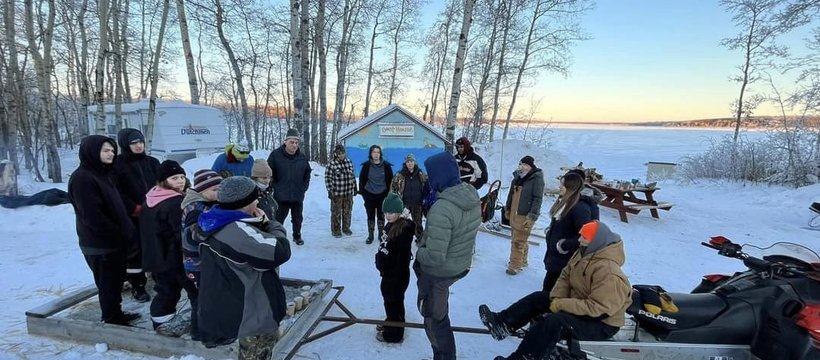
Youth connect to traditional land use at winter camp
While spending a weekend outdoors during a Saskatchewan winter might not be everyone’s cup of tea, for the participants of a traditional land-use winter camp, it was an opportunity to grow their personal connection to the land.
The Métis Nation Saskatchewan Eastern Region III (ERIII) kicked off 2023 by holding its second-ever ERIII Traditional Land Use Winter Camp at Kenosee Lake. For a weekend in January, participants, land-based educators, and Elder Calvin Racette set up tents and tipis outdoors to spend the days practicing land-based activities such as trapping and dogsledding.
Garrick Schmidt, a traditional land-based educator with ERIII, is amazed at the growth of the camp, and says that the first winter camp in 2021 helped build a good foundation.
“There’s a sense of pride and belonging that participants have, of being from here, and being able to do these traditional things that might have been lost and forgotten — due to Residential schools, due to the 60’s scoop, or even just with family members not passing on traditional knowledge,” Schmidt says. “The camps that we are running are on Métis homeland territory with families that have a historical connection to the area.”
Because many traditional activities take place during winter, the camp was also an opportunity to prepare participants for being outdoors in extreme weather. “We’re making sure that people are set up for success,” says Schmidt, by educating people about hypothermia and teaching survival skills.
“It’s a good test of your equipment, your gear, your clothing, and also of yourself. It shows people in a controlled, safe environment what their limits can be,” he says. “They don’t have to read about it in a textbook — these are lived experiences.”
Schmidt, who grew up in Indian Head as part of a Métis family from Qu’Appelle Valley, says he was always outside, learning what he could from his mom and grandparents, since he was a kid. As he grew up, he learned from Elders, mentors and uncles about hunting, harvesting medicine and more. Now, as an educator, his goal is to pass on what he has learned to the next generations.
“It is so amazing to be able to see six, seven-year-old children, all the way to 25-year-old adults, learning how to trap, run dogs, work on hides, how to sew, and learning their language,” Schmidt says. “There’s that sense of pride. There’s that sense of reconnection to their culture, their values, and who we are as Indigenous people. And then, they’re able to go and share that sense of belonging and pride with their friends.”
Schmidt says, fondly, that the youth that came to the camp are “already bugging us about when the next one is.” His hope is that one day there will be Indigenous-led, land-based programs and schools all over that are government-funded, same as other education programs. He hopes that the kids he teaches now will be part of this dream for the future, as educators and facilitators themselves.
“I think that’d be pretty historical to see,” he says, “for kids to be able to say, hey, we were a part of this.”
The Métis Nation Saskatchewan Eastern Region III received project funding from the Métis Cultural Development Fund, administered by Gabriel Dumont Institute with funding from Sask Lotteries.


 Engage - Volume 14, Issue 1, Fall 2023
Engage - Volume 14, Issue 1, Fall 2023